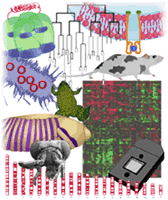klock hier
.enaut> wie gehts ?
hallo telenaut
gut
gut qualitaet
ωνω BitchX: Now logging messages to: /home/tilo/.BitchX/BitchX.away
π tr3losin is away: (Auto-Away after 10 mins) [BX-MsgLog On]
ωνω You have been marked as being away
ja gut gut
!!!!!!!!
gut gut gut
>gnl|UG|Rn#S18368 EST195029 Rattus norvegicus cDNA, 3' end
/clone=RHEAQ75 /clone_end=3' /gb=AA891226 /gi=3018105 /ug=Rn.2
/len=607GGAACGGGTACTATTATTTATTATAACCAGGGCACTCCACCTTCCCTCAGGGGATAGATG
AAGTATACTTGTCATGTAAGTCAGCTACATTGTCACTGGAGACACGGATCCAGCCATCCTCCCGCACA
TGGTAGAGGTTGACTGCTCCTCCGGAGTAGGCATCTCTGTAGGTGGCTTGGTAGATGGCTCGGCGGGC
CAGGTCATAGGCCTCCTCCACTTGTAGGTCATAGGAGTAGCCTCGATCCATGACTCCAAACGCATACA
CGGAGCCAGATCCCACTGAGAAGGCGGTTCCAGAGATCCTGTTCCCC
[02:10am][tr3losin(+iw) (zZzZ 0)] [#telenauti]
[Lag 0] [O/0 N/6 I/0 V/0

Development of a genetic map of soybean
Soybean breeders and geneticists need a soybean genetic map to breed soybean more
efficiently. We are developing a soybean genetic map containing RFLP (Restriction
Fragment Length Polymorphisms), RAPD (Random Amplified Polymorphic DNA, AFLP
(Amplified Fragment Length Polymorphisms), SSR (Single Sequence Repeats) and
phenotypic markers. RFLP mapping is used to place DNA sequences of known genes on
the map. More than forty RFLP probes were one-pass sequenced at their ends to
transform them into sequence tagged sites. Some are genomic clones, while others
encode such proteins as aspartokinase, homoserine dehydrogenase, asparagine
synthetase, 34 kDA oil body protein, aspartate aminotransferase, dihydrodipicolinic
acid synthase, a sulfate transporter, lipoxygenase, HSP 83, and a protein kinase. Also,
we are using a new technique, AFLP, to produce a soybean map more rapidly. AFLP is
a sophisticated PCR-based technique that separates labeled, amplified genomic
fragments on a DNA sequencing gel. Fifty to seventy five bands are resolved in each
gel lane and six to twelve bands are usually polymorphic. It is a labor intensive but
efficient technique as compared to RFLP mapping. Data for about 75 loci have been
collected using AFLP. Our map will be linked to other soybean maps by placing SSRs on
our map that have been mapped on other soybean maps. Data from RFLP, RAPD, AFLP
and SSR analysis are combined with data for phenotypic markers to produce a
soybean map. This work is useful to soybean breeders, geneticists, and genome
mappers to formulate approaches for breeding elite soybean lines.
otherwise empty data. to understand the
otherwise empty data. to under the
otherwise empty data. to underand the
otherwise empty data. to understand the
otherwise empty data. to understand the
otherwise empty data. | |
|

Link to this Page
- enter. last edited on 19 October 2011 at 12:26 pm by f052054044.adsl.alicedsl.de

 |
|![]()